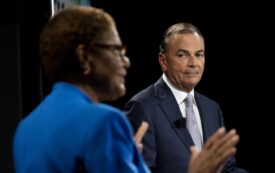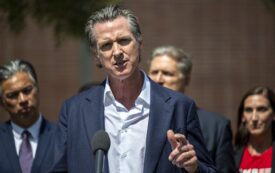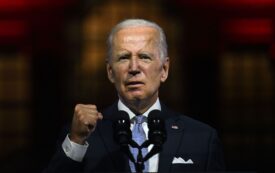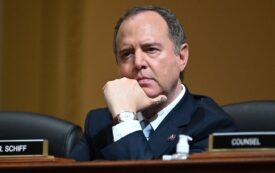For the past several months, the Federal Reserve has used a traditional toolkit to attempt to rein in the high inflation that was unleashed by the pandemic and worsened by Russia’s attack on Ukraine.
This traditional model for responding to inflation, hewed to by economists for decades, posits that inflation is triggered by excess demand, and that the way to rein in demand (and thus to put the brakes on inflation) is to raise the cost of borrowing. Hence the rush upward in the interest rate set by the Federal Reserve, and, by extension, the increased cost of borrowing for companies looking to finance new investments and for consumers looking to get mortgages from banks. In the summer of 2021, for a buyer with good credit, a 30-year mortgage could be approved at a 2.75 percent interest rate. Last week, those mortgages headed north of 6 percent. For a family with, say, a $400,000 mortgage, that’s a difference of roughly $14,000 per year. Not surprisingly, millions of people are deferring home purchases. Between the moment when mortgage rates hit their lows last summer and now, the demand for mortgages has declined by nearly a third.
The idea is pretty straightforward: If it costs more — perhaps a lot more — to borrow, people will defer purchases. Fewer new cars, fewer house purchases and fewer big-spending items put on credit cards lead to companies needing fewer employees, which in turn recalibrates the labor market away from worker-power, making it harder for employees, in a soft labor market, to bargain up their wages. That particular circle will, the idea goes, rapidly put the squeeze on inflation.
The theory, which is epitomized by an economic graph known as the Phillips Curve, says that a little bit of short-term consumer pain, and a willingness to tolerate higher levels of unemployment for a few months or even a couple years, ought to do the trick in putting the inflation genie back in its bottle. Proponents of this model argue that workers’ short-term pain is more than compensated for by the longer-term gains that come with stable prices.
Yet, a strange thing is happening in this current bout with inflation, as many progressive economists, such as Joseph Stieglitz and Dean Baker, had predicted would be the case. As interest rates soar, housing demand is, indeed, easing back, as the model would predict. But the broader labor market remains tight — in part because so many Americans dropped out of the job market during the pandemic, either out of fear of exposure, because they couldn’t find child care, or in many instances, because they ended up suffering debilitating effects from long COVID. And, despite momentary optimism that inflation was peaking in June and July, the recently released numbers for August, which sent the stock market into a swoon last week, suggest that a higher-than-wanted level of inflation (the Federal Reserve aims for inflation in the 2 percent range) is firmly entrenched at the moment.
Similarly bad inflation numbers are also being posted by other major industrial democracies: The inflation rate in the U.K. is slightly higher than in the U.S., and some models predict it could hit as much as 18 percent by year’s end, although these worst-case scenarios are likely to have been muted somewhat by Prime Minister Liz Truss’s recent announcement that the government would cap energy prices. In the EU, the inflation rate is above 9 percent. In Canada, it is just under 8 percent. In Australia, inflation is hovering at around 6 percent. And even in Japan, which has extraordinarily low levels of inflation due in part to decades of stagnant growth, and in part to the government subsidizing a wide range of consumer products, all the inflation indicators have gone up in recent months, though price increases still remain far less of a problem there than in most other wealthy nations.
This stubborn persistence of inflation globally oughtn’t to be surprising: the traditional model assumes inflation is triggered by excess demand, and thus can be curbed by reining in demand. But the last couple years of supply chain disruptions have shown that when an unpredicted but catastrophic “black swan event” such as a pandemic holds the world in its grip, prices around the world get driven up by a cascading series of glitches that make it harder both to produce goods and then to ship the finished product to stores and to consumers.
Why, for example, are consumers paying so much more for cars? Not because there’s suddenly been a spike in the number of drivers on the road, but because at every level of the supply chain — from rubber and steel to semiconductors — there are shortages or delivery bottlenecks. In the globalized economy, a consumer in an import-heavy economy such as the U.S. is particularly vulnerable to, say, price spikes caused by supply shortages triggered by COVID lockdowns half a world away in China.
Given this, raising interest rates ad nauseam is an extraordinarily clumsy way to deal with the problem. Sure, eventually demand will be curbed so much by the unaffordability of borrowing money that it will tamp down inflation. But before it does that, it’s likely to cause a huge amount of pain. And that hurt won’t be evenly distributed.
Since the labor market remains tight, those higher up the economic ladder, those with more marketable skills and higher education qualifications, are more frequently able to largely neutralize the loss of purchasing power that comes with inflation through successfully negotiating for wage increases, for starting bonuses, and for other compensation.
As a result, the inflation spiral will most heavily impact poorer residents, who have less money saved; have less power to negotiate wage increases; and have poorer credit to begin with, meaning that they will pay disproportionately more when they seek to borrow during a moment of rising interest rates.
Meanwhile, low-income residents face particularly dire circumstances in poorer countries, mainly in the global South, whose governments lack the clout to intervene in the energy and food markets to try to lower costs or to cushion the blow on poorer people through implementing price subsidies for food and energy. In much of the world, inflation, triggered by the twinned dislocations of pandemic and of war, is soaring beyond anything experienced in the first world. Argentina’s inflation is roughly 80 percent, Lebanon’s 116 percent, Sri Lanka’s increased from 5.7 percent a year ago to over 60 percent today, and so on.
Last week, the head of the United Nations World Food Programme warned that up to 345 million people worldwide — or roughly 50 times the number known to have died from COVID so far — could face starvation as food prices soar and as shortages increase. This represents a doubling in global food insecurity since early 2020. Already, roughly 50 million people are facing acute malnutrition. With the recent catastrophic flooding in Pakistan, and the displacement of tens of millions from their homes, that number will surely increase over the coming months. The war in Ukraine, with the resulting disruptions to global markets in grain, wheat, soy and other staples has, the UN estimates, pushed 70 million people closer to starvation.
The UN’s stark warning ought to have generated headlines around the world; instead, it simply became a side story.
But, even while economics writers around the world fixate on spiraling inflation in economic powerhouses such as the U.S., the U.K. and the EU bloc, while ignoring even worse inflation — and the damage it causes — in poor countries, there are underlying similarities. To be poor anywhere on Earth is to bear a disproportionate brunt of the impact of failing, one-size-fits-all policies. To be poor is to bear the brunt of inflation spirals; but to be poor is also to bear the brunt of shock-and-awe policy responses designed to wrestle inflation back under control.
There are, however, alternatives ideas on the table for tackling inflation in a fairer way. Last week, the Center for American Progress released a report detailing how the supply chain could be strengthened so as to reduce disruptions and thus rein in prices. The authors called for ramping up COVID vaccine distribution; expanding the child care system so that parents could return to work; increasing immigration levels in countries such as the U.S. to fill jobs left empty by the contracting workforce; going after price-gouging trusts; and ramping up investments in renewable energy so as to wean the economy from fossil fuels and from the profiteering companies who have made such fortunes during the price-increase months since Russia attacked Ukraine in February.
The authors concluded that the Fed’s approach, looking to gently tamp down demand without sinking the economy into a deep recession, was unlikely to work to knock excess inflation out of the economy. They warned that if the Fed keeps raising interest rates, eventually the landing could be extremely hard and painful — in other words, this strategy risks crashing both the housing and the job markets, which would hurt poor Americans the most. Better, they argued, to craft an economic policy that “addresses the supply issues brought into high relief during this recovery.”
Because of the Fed’s outsized influence on global economic policy, the rest of the world is likely to follow where the U.S. goes on interest rates. Raising interest rates moderately may make sense as one tool among many to tackle this rather unique inflationary moment, but raising them immoderately — and excluding more unorthodox supply side anti-inflation interventions — risks doing long-term damage to those at the bottom of the economy. Doing so poses an acute threat to the poor both within the U.S. and in less affluent countries overseas, which could end up plagued by persistently high inflation, rising unemployment and ever-greater difficulties accessing loans for businesses and for house purchases. That’s the sort of lose-lose proposition that could create cascading problems for decades to come.
This post was originally published on Latest – Truthout.














